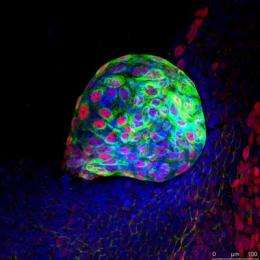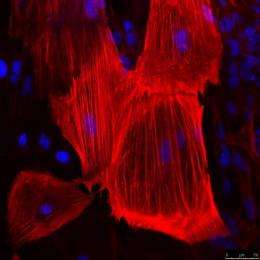It's in the bank: Human cord blood reprogrammed into embryonic-like stem cells

Human umbilical cord blood cells may be far more versatile than previous research has indicated. Two independent studies, published by Cell Press in the October 2nd issue of the journal Cell Stem Cell, report that they have successfully reprogrammed human umbilical cord blood cells into cells with properties similar to human embryonic stem cells. The results are significant as they identify cord blood as a convenient source for generating cells with a theoretically limitless potential.
Recent research has shown that adult cells can be reprogrammed into cells with characteristics similar to embryonic stem cells by turning on a select set of genes. The cells, called induced pluripotent stem (iPS) cells, have tremendous potential for regenerative medicine. However, issues related to difficulty harvesting adult cells, inefficient reprogramming and the accumulation of genetic errors (mutations) that may contribute to an increased risk for cancer and diminished cellular functionality have presented formidable challenges. Human umbilical cord blood cells have been suggested as an attractive alternative to adult cells for reprogramming.
"Cord blood-derived cells can be collected without any risk for the donor, are young cells expected to carry minimal mutations and possess the immunological immaturity of newborn cells. We believe that cord blood cells could represent, rather than just another cell type that can be reprogrammed, a real alternative for a safer source of iPS cells," explains senior study author Dr. Izpisua Belmonte from the Center of Regenerative Medicine in Barcelona, Spain and The Salk Institute in La Jolla, California.

Dr. Izpisua Belmonte and colleagues described a specific process that converted human cord blood cells into embryonic-like stem cells using only two factors. "From a mechanistic point of view, the fact that cord blood-derived iPS cells could be generated by activating only two genes is a crucial point that offers new possibilities for investigating the molecular basis of the reprogramming process," concludes Dr. Izpisua Belmonte.
In a separate study, led by Dr. Ulrich Martin from Hannover Medical School in Hannover, Germany, cord blood cells were also used to generate cells that exhibited characteristics typical of embryonic stem cells. Dr. Martin and colleagues demonstrated that the iPS cells had the potential to differentiate into multiple mature cell types, including functional heart muscle cells. "Our study provides a feasible strategy for the reproducible generation of iPS cells from human cord blood" offers Dr. Martin. "Importantly, public and commercial cord blood banks may provide a superior and almost unlimited source of for the production of clinically useful iPS cells."
Both research groups highlight the substantial clinical convenience of the existing networks for banking human cord blood and the theoretical advantage of these "young" cells in that they may have a decreased risk of having accumulated damaging genetic mutations associated with adult cells. The successful reprogramming of human cord blood cells into pluripotent stem cells is an important step towards future regenerative therapies. "Our findings should facilitate the clinical translation of iPS cell-based therapies," says Dr. Izpisua Belmonte.
Source: Cell Press (news : web)















